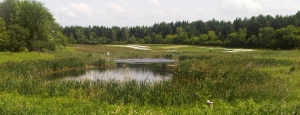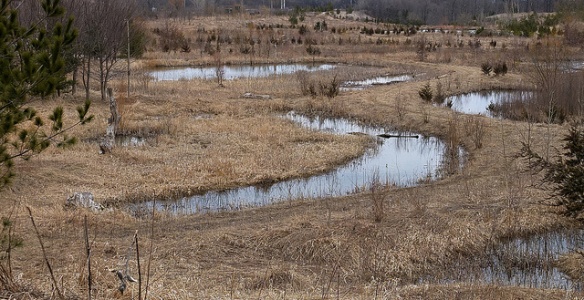Difference between revisions of "Wetlands"
Jump to navigation
Jump to search
Jenny Hill (talk | contribs) m |
Jenny Hill (talk | contribs) m (→Design) |
||
| Line 31: | Line 31: | ||
==Planning considerations== | ==Planning considerations== | ||
==Design== | ==Design== | ||
| + | {| class="wikitable" | ||
| + | !Element | ||
| + | !Design Objective | ||
| + | !Criteria | ||
| + | |- | ||
| + | |Drainage Area | ||
| + | |Sustaining vegetation, volumetric turnover | ||
| + | |5 Ha (≥10 Ha preferred) | ||
| + | |- | ||
| + | |Treatment Volume | ||
| + | |Provision of appropriate level of protection (Table 3.2) | ||
| + | |See Table 3.2 | ||
| + | |- | ||
| + | |Active Storage | ||
| + | |Detention | ||
| + | |Suspended solids settling 24 hrs (12 hrs if in conflict with min. orifice size) | ||
| + | |- | ||
| + | |Forebay | ||
| + | |Pre-treatment | ||
| + | |Minimum depth: 1 m; ii) Sized to ensure non-erosive velocities leaving forebay; iii) Maximum area: 20 % of total permanent pool | ||
| + | |- | ||
| + | |Length-to-Width Ratio | ||
| + | |Maximize flow path and minimize short-circuiting potential | ||
| + | |i) Overall: minimum 3:1; ii) Forebay: minimum 2:1 | ||
| + | |- | ||
| + | |Permanent Pool Depth | ||
| + | |Vegetation requirements, rapid settling | ||
| + | |The average permanent pool depth should range from 150 mm to 300 mm | ||
| + | |- | ||
| + | |Active Storage Depth | ||
| + | |Storage/flow control, sustaining vegetation | ||
| + | |Maximum 1.0m for storms < 10 year event | ||
| + | |- | ||
| + | |Side Slopes | ||
| + | |Safety | ||
| + | |i) 5:1 For 3 m above and below permanent pool (ii) Maximum 3:1 elsewhere | ||
| + | |- | ||
| + | |Inlet | ||
| + | |Avoid clogging/freezing | ||
| + | |i) Minimum 450 mm; ii) Preferred pipe slope: >1%; iii) If submerged, obvert 150 mm below expected maximum ice depth | ||
| + | |- | ||
| + | |Outlet | ||
| + | |Avoid clogging/freezing | ||
| + | |i) Minimum: 450mm outlet pipe; ii) Preferred pipe slope: >1%; iii) If orifice control used, 75mm diameter minimum; (iv) Minimum 100mm orifice preferable | ||
| + | |- | ||
| + | |Maintenance Access | ||
| + | |Access for backhoes or dredging equipment | ||
| + | |(i) Provided to approval of Municipality; (ii) Provision of maintenance drawdown pipe preferred | ||
| + | |- | ||
| + | |Buffer | ||
| + | |Safety | ||
| + | |Minimum 7.5 m above maximum water quality/erosion control water level | ||
| + | |} | ||
| + | |||
==Performance== | ==Performance== | ||
STEP (under previous name SWAMP) conducted their own research into the performance of stormwater wetlands, the project page and report can be viewed [https://sustainabletechnologies.ca/home/urban-runoff-green-infrastructure/conventional-stormwater-management/constructed-wetlands/performance-assessment-of-an-open-and-covered-stormwater-wetland-system-aurora-ontario/ here]. | STEP (under previous name SWAMP) conducted their own research into the performance of stormwater wetlands, the project page and report can be viewed [https://sustainabletechnologies.ca/home/urban-runoff-green-infrastructure/conventional-stormwater-management/constructed-wetlands/performance-assessment-of-an-open-and-covered-stormwater-wetland-system-aurora-ontario/ here]. | ||
Revision as of 01:07, 29 September 2018
Overview[edit]
Wetlands are an ideal technology for:
- Text A
- Text B
| Type A | Type B | Type C |
|---|---|---|
| Surface water | Minimal Any surface flow can be slowed with check dams |
Ponding is encouraged with check dams |
| Soil | Filter media required | Amendment preferable when possible |
| Underdrain | Common | Uncommon |
| Maintenance | Medium to high | Low |
| Stormwater benefit | High | Moderate |
| Biodiversity benefit | Increased with native planting | Typically lower |
Planning considerations[edit]
Design[edit]
| Element | Design Objective | Criteria |
|---|---|---|
| Drainage Area | Sustaining vegetation, volumetric turnover | 5 Ha (≥10 Ha preferred) |
| Treatment Volume | Provision of appropriate level of protection (Table 3.2) | See Table 3.2 |
| Active Storage | Detention | Suspended solids settling 24 hrs (12 hrs if in conflict with min. orifice size) |
| Forebay | Pre-treatment | Minimum depth: 1 m; ii) Sized to ensure non-erosive velocities leaving forebay; iii) Maximum area: 20 % of total permanent pool |
| Length-to-Width Ratio | Maximize flow path and minimize short-circuiting potential | i) Overall: minimum 3:1; ii) Forebay: minimum 2:1 |
| Permanent Pool Depth | Vegetation requirements, rapid settling | The average permanent pool depth should range from 150 mm to 300 mm |
| Active Storage Depth | Storage/flow control, sustaining vegetation | Maximum 1.0m for storms < 10 year event |
| Side Slopes | Safety | i) 5:1 For 3 m above and below permanent pool (ii) Maximum 3:1 elsewhere |
| Inlet | Avoid clogging/freezing | i) Minimum 450 mm; ii) Preferred pipe slope: >1%; iii) If submerged, obvert 150 mm below expected maximum ice depth |
| Outlet | Avoid clogging/freezing | i) Minimum: 450mm outlet pipe; ii) Preferred pipe slope: >1%; iii) If orifice control used, 75mm diameter minimum; (iv) Minimum 100mm orifice preferable |
| Maintenance Access | Access for backhoes or dredging equipment | (i) Provided to approval of Municipality; (ii) Provision of maintenance drawdown pipe preferred |
| Buffer | Safety | Minimum 7.5 m above maximum water quality/erosion control water level |
Performance[edit]
STEP (under previous name SWAMP) conducted their own research into the performance of stormwater wetlands, the project page and report can be viewed here.
Gallery[edit]
Emergent wetland vegetation supported by stormwater runoff at Kino Environmental Restoration Project. Photo by Matthew Grabau, US Fish and Wildlife Service
Azalea Park, Charlottesville VA - "This side of the park, formerly located along a runoff channel that led into Moore's Creek, has been converted into a wetland which supports a surprising amount of insect and amphibian life." -Credit and Photo: Scott Clark (certhia on Flickr).




